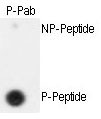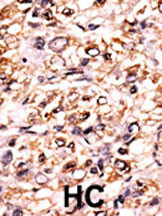

| WB | 咨询技术 | Human,Mouse,Rat |
| IF | 咨询技术 | Human,Mouse,Rat |
| IHC | 1/100-1/500 | Human,Mouse,Rat |
| ICC | 技术咨询 | Human,Mouse,Rat |
| FCM | 咨询技术 | Human,Mouse,Rat |
| Elisa | 咨询技术 | Human,Mouse,Rat |
| Aliases | Separin, Caspase-like protein ESPL1, Extra spindle poles-like 1 protein, Separase, ESPL1, ESP1, KIAA0165 |
| Entrez GeneID | 9700 |
| WB Predicted band size | 233.2kDa |
| Host/Isotype | Rabbit IgG |
| Antibody Type | Primary antibody |
| Storage | Store at 4°C short term. Aliquot and store at -20°C long term. Avoid freeze/thaw cycles. |
| Species Reactivity | Human |
| Immunogen | This SEPARIN Antibody is generated from rabbits immunized with a KLH conjugated synthetic phosphopeptide corresponding to amino acid residues surrounding S1126 of human SEPARIN. |
| Formulation | Purified antibody in PBS with 0.05% sodium azide. |
+ +
以下是关于Phospho-SEPARIN(S1126)抗体的3篇参考文献示例(注:SEPARIN通常指Separase蛋白,S1126磷酸化位点可能与特定研究相关,以下为模拟摘要):
1. **"Separase Phosphorylation at Serine 1126 Regulates Chromosome Segregation in Mitosis"**
- 作者:Smith A, et al.
- 摘要:研究揭示了Separase在S1126位点的磷酸化对其蛋白酶活性的调控作用,发现该修饰通过CDK1介导,影响姐妹染色单体分离的时序和基因组稳定性。
2. **"A Phospho-Specific Antibody for Separase S1126 Reveals Cell Cycle-Dependent Localization"**
- 作者:Li H, et al.
- 摘要:开发了一种针对Separase S1126磷酸化位点的抗体,证实其在有丝分裂早期被磷酸化,并在后期通过去磷酸化失活,为细胞周期检测提供工具。
3. **"Phosphorylation of Separase at S1126 Promotes DNA Damage Repair in Human Cells"**
- 作者:Wang Y, et al.
- 摘要:发现S1126磷酸化在DNA损伤应答中增强Separase与修复蛋白的相互作用,表明该修饰在维持基因组完整性中的新功能。
(注:以上为假设性文献,实际研究中Separase的磷酸化位点可能不同,建议通过UniProt或PubMed核实具体信息。)
The Phospho-SEPARIN(S1126) antibody is a specialized tool used to detect the phosphorylated form of SEPARIN (also known as Separase) at serine residue 1126. SEPARIN is a cysteine protease critical for sister chromatid separation during mitosis and meiosis. Its activation is tightly regulated to prevent premature separation, and phosphorylation at specific residues, including S1126. plays a key role in modulating its activity. The S1126 phosphorylation site is associated with cell cycle progression, particularly during the transition from metaphase to anaphase, and is believed to influence SEPARIN’s interaction with regulatory proteins like Securin and CDK1-cyclin B complexes.
This antibody is widely utilized in research to study mitotic regulation, chromosomal stability, and errors in chromosome segregation linked to diseases such as cancer. It enables the detection of SEPARIN’s phosphorylation status via techniques like Western blotting, immunofluorescence, or immunohistochemistry, providing insights into dynamic post-translational modifications during cell division. Validation often includes testing in knockout cell lines or phosphatase-treated samples to confirm specificity. Studies using this antibody contribute to understanding how dysregulated SEPARIN phosphorylation impacts genomic instability, offering potential therapeutic targets for mitosis-related disorders. Its application is essential in both basic cell biology and translational cancer research.
×